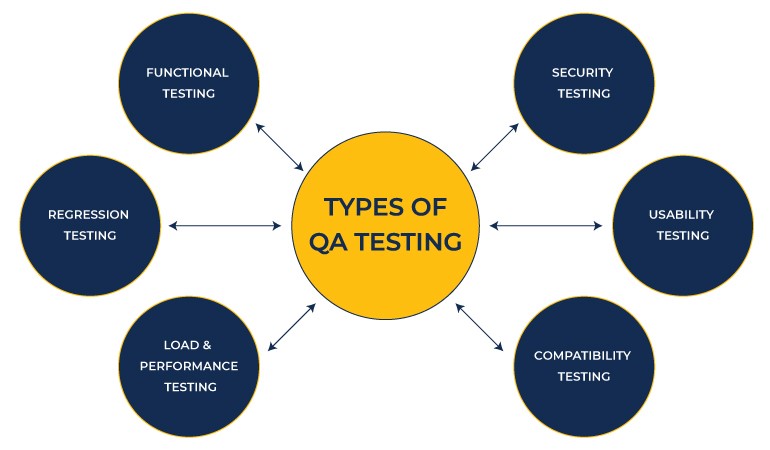Quality Assurance (QA) testing is a critical aspect of software development that ensures the final product meets the desired quality standards. With integration services growing at an unprecedented pace and newer software options popping up every now and then, successful QA testing has become more important than ever.
As such, it’s a no-brainer for IT businesses to adopt best practices that guarantee effective QA testing of their software products. In this blog post, we’ll explore what QA testing entails and provide some tips and tricks on improving your company’s approach to it.
So, buckle up, and let’s dive into QA testing services!

Defining Quality Assurance (QA)
Quality Assurance (QA) is the systematic process of ensuring that software products meet the desired quality standards. Its primary goal is to identify and resolve any issues or bugs before a product reaches end-users, guaranteeing an optimal user experience.
QA testing involves different stages of review and testing to achieve an optimal user experience, from requirements analysis to post-release validation. This comprehensive approach enables developers to detect functional defects while also identifying areas for improvement in terms of usability and performance.
Another aspect of QA testing is the use of test cases, which are specific scenarios designed to simulate how users will interact with the software. Test cases can range from simple input/output exercises to complex multi-step processes that require several system integrations, all aimed at uncovering potential weaknesses in the system.
Let’s discuss the QA process in further detail.
The QA Process
The QA process is a crucial step in any software development lifecycle. Quality assurance in software development, much like QA in any other industry, is all about ensuring that the end product meets the requirements and goals set by the stakeholders.
This process begins with planning, where the scope of testing is defined based on factors such as project size, complexity, and industry standards.
The next step is designing test cases to cover different scenarios that might arise during usage. These test cases are then executed using various techniques, such as manual testing or automation tools. Software engineers and QA specialists analyze the results of these tests to identify bugs or defects that need fixing.
Once they have resolved all the defects, QA experts perform regression testing to ensure no new issues have arisen while fixing previous ones. Acceptance testing takes place before releasing the product into production.
A well-defined QA process can ensure a high-quality end product that meets user expectations and reduces costly errors down the line.
The Importance of QA Testing
The significance of quality assurance testing cannot be overstated – it is an essential part of the software development process. The QA process ensures that the product meets the desired quality standards and requirements to satisfy customer needs. It does so by preventing costly errors and saving time in the long run.
Effective QA testing helps detect issues early in the development process, leading to a quicker resolution before they become major problems. By identifying bugs and defects in software systems, developers can address them promptly, thus reducing financial losses resulting from delays or recalls.
Effective QA testing not only saves time and money but also enhances user experience by ensuring that products are reliable, functional, secure, and easy to use. Users expect high-quality products that work seamlessly without any glitches or crashes; therefore, meeting these customer expectations should always be a top priority for any company developing software solutions.
Moreover, conducting thorough QA testing also builds trust with customers while improving brand reputation, as it demonstrates the commitment to delivering reliable solutions that effectively meet their needs.
In today’s competitive market, customer satisfaction is paramount. Failing to provide high-quality products often results in losing loyal customers who switch to competitors offering better experiences.
Types of QA Testing
Companies use several types of QA testing to ensure high-quality products. Here are some of the leading testing types you should know.
- Functional Testing – it involves testing the product’s functionality according to its specifications.
- Regression Testing – tests for any new defects introduced during product changes or updates, ensuring that previously functioning features continue to work as expected.
- Load and Performance Testing – it checks whether a product can handle high levels of traffic or usage without crashing or slowing down.
- Security Testing – it identifies potential security vulnerabilities and helps prevent data breaches.
- Usability Testing – it evaluates how user-friendly a product is by observing users’ interactions with it.
- Compatibility Testing – it checks if the product works seamlessly with different platforms and devices.

It is very important to incorporate the various types of QA testing into your development process. Testing allows you to improve the overall quality and reliability of products, leading to greater customer satisfaction and loyalty.
Best Practices for Effective QA Testing
Following and implementing the QA best practices is the best way to ensure that your QA testing process is robust and effective.
Here are some best practices successful QA testing involves:
- First, establish clear and concise requirements before starting any testing. This will allow you to identify what needs to be tested and how it should work. It will also prevent misunderstandings between the development team and testers.
- Next, create a comprehensive test plan that includes all the types of tests you need, such as functional, performance, usability, or security testing. A well-planned test strategy can lead to better coverage of test scenarios resulting in high-quality products.
- Prioritize defects based on severity levels so developers can address critical issues first while allowing testers to focus their efforts on identifying other potential problems.
- Automate wherever possible with tools like Selenium or Appium, which can save time and reduce human error during repetitive tasks like regression testing.
- Communicate effectively with everyone involved in the project, including developers, designers, and other stakeholders. Clear communication is vital to ensuring quality products are delivered within deadlines.
Conclusion
Every software house knows the critical role of the QA testing process in their business model. It is one of those crucial functions without which the whole edifice of an IT company will crumble as it would naturally fail to deliver software without bugs and issues.
QA’s role is to ensure that the final product meets customer expectations and industry standards, thus helping the business improve its bottom line and retain customers. By following these best practices for effective QA testing, you can streamline your process, enhance the quality of the product, and reduce costs associated with defects and errors.
Remember to involve all stakeholders in the planning and execution of QA testing processes, including developers, testers, project managers, and business owners. Use a variety of testing methods to ensure comprehensive coverage of functionality across different platforms.
Prioritize continuous improvement by analyzing test results regularly to identify trends or areas for improvement. With these tips in mind, you’ll be well on your way to achieving successful outcomes through effective QA testing!
If you need further assistance with QA testing, contact us at [email protected].

